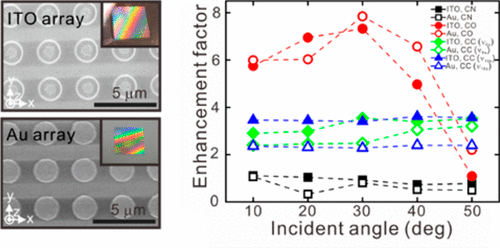当前位置:
X-MOL 学术
›
ACS Photonics
›
论文详情
Our official English website, www.x-mol.net, welcomes your
feedback! (Note: you will need to create a separate account there.)
Surface-Enhanced Infrared Absorption for the Periodic Array of Indium Tin Oxide and Gold Microdiscs: Effect of in-Plane Light Diffraction
ACS Photonics ( IF 6.5 ) Pub Date : 2018-02-03 00:00:00 , DOI: 10.1021/acsphotonics.7b01265 Ryosuke Kamakura 1 , Tomoki Takeishi 1 , Shunsuke Murai 1, 2 , Koji Fujita 1 , Katsuhisa Tanaka 1
ACS Photonics ( IF 6.5 ) Pub Date : 2018-02-03 00:00:00 , DOI: 10.1021/acsphotonics.7b01265 Ryosuke Kamakura 1 , Tomoki Takeishi 1 , Shunsuke Murai 1, 2 , Koji Fujita 1 , Katsuhisa Tanaka 1
Affiliation

|
Surface-enhanced infrared absorption (SEIRA) is an important phenomenon to achieve nondestructive, simplified, and in situ high-sensitivity infrared (IR) sensors. Conventionally, metal structures with nanogaps are employed to realize the high sensitivity owing to the extremely strong field enhancement in the hot spot. Although a library of surface modifiers has been developed, the manipulation of nanogaps and immobilization of target molecules in the hot spot are still complicated. In addition, target molecules immobilized at the positions other than the hot spot have relatively low sensitivity. A periodic array with pitch comparable to the wavelength of interest is an alternative structure in which the coupling of the plasmonic mode to in-plane light diffraction provides the hybrid mode accompanied by an enhanced electric field. Although the field enhancement by the hybrid mode depends on matching between localized surface plasmon resonance (LSPR) and diffraction, the contribution of the matching to SEIRA enhancement has never been clarified. In this work, we fabricated periodic arrays of indium tin oxide (ITO) and Au microdiscs (pitch: 3 μm, diameter: 2 μm) to analyze the contribution of the hybrid mode through varied LSPR and diffraction conditions. As a result, the ITO and Au arrays demonstrate a similar plasmonic–photonic hybrid mode in the mid-IR region despite the different excitation frequency of LSPR. To estimate the effect of the hybrid mode on SEIRA enhancement, the incident angular profiles of IR spectra of the polymer layer on the ITO and Au arrays were measured. The SEIRA enhancement factors for ITO and Au arrays are comparable in the IR measurement region (2200–1400 cm–1). Our results verify that the plasmonic–photonic hybrid mode is very efficient for SEIRA enhancement, and the periodic array of microdiscs is very suitable for this application.
中文翻译:

铟锡氧化物和金微盘周期阵列的表面增强红外吸收:平面光衍射的影响
表面增强红外吸收(SEIRA)是实现无损,简化和原位的重要现象高灵敏度红外(IR)传感器。常规地,由于在热点中极强的场增强,因此采用具有纳米间隙的金属结构来实现高灵敏度。尽管已经开发了表面改性剂库,但是纳米间隙的操纵和目标分子在热点中的固定化仍然很复杂。另外,固定在热点以外的位置上的靶分子的灵敏度较低。具有可与所关注的波长相比的节距的周期阵列是一种替代结构,其中等离子体模式与面内光衍射的耦合提供了伴随增强电场的混合模式。尽管通过混合模式进行的场增强取决于局部表面等离子体激元共振(LSPR)与衍射之间的匹配,匹配对SEIRA增强的贡献尚未阐明。在这项工作中,我们制作了铟锡氧化物(ITO)和金微盘的周期性阵列(间距:3μm,直径:2μm),以分析杂化模式在变化的LSPR和衍射条件下的作用。结果,尽管LSPR的激发频率不同,但ITO和Au阵列在中红外区域显示出类似的等离激元-光子混合模式。为了估计混合模式对SEIRA增强的影响,测量了ITO和Au阵列上聚合物层的IR光谱的入射角分布。ITO和金阵列的SEIRA增强因子在红外测量区域(2200–1400厘米)中具有可比性 我们制作了铟锡氧化物(ITO)和金微盘的周期性阵列(间距:3μm,直径:2μm),以分析杂化模式在变化的LSPR和衍射条件下的作用。结果,尽管LSPR的激发频率不同,但ITO和Au阵列在中红外区域显示出相似的等离激元-光子混合模式。为了估计混合模式对SEIRA增强的影响,测量了ITO和Au阵列上聚合物层的IR光谱的入射角分布。ITO和金阵列的SEIRA增强因子在红外测量区域(2200–1400厘米)中具有可比性 我们制作了铟锡氧化物(ITO)和金微盘的周期性阵列(间距:3μm,直径:2μm),以分析杂化模式在变化的LSPR和衍射条件下的作用。结果,尽管LSPR的激发频率不同,但ITO和Au阵列在中红外区域显示出相似的等离激元-光子混合模式。为了估计混合模式对SEIRA增强的影响,测量了ITO和Au阵列上聚合物层的IR光谱的入射角分布。ITO和金阵列的SEIRA增强因子在红外测量区域(2200–1400厘米)中具有可比性 尽管LSPR的激发频率不同,但ITO和Au阵列在中红外区域表现出相似的等离子-光子混合模式。为了估计混合模式对SEIRA增强的影响,测量了ITO和Au阵列上聚合物层的IR光谱的入射角分布。ITO和金阵列的SEIRA增强因子在红外测量区域(2200–1400厘米)中具有可比性 尽管LSPR的激发频率不同,但ITO和Au阵列在中红外区域表现出相似的等离子-光子混合模式。为了估计混合模式对SEIRA增强的影响,测量了ITO和Au阵列上聚合物层的IR光谱的入射角分布。ITO和金阵列的SEIRA增强因子在红外测量区域(2200–1400厘米)中具有可比性–1)。我们的结果证明,等离激元-光子混合模式对于SEIRA增强非常有效,微盘的周期性阵列非常适合此应用。
更新日期:2018-02-03
中文翻译:

铟锡氧化物和金微盘周期阵列的表面增强红外吸收:平面光衍射的影响
表面增强红外吸收(SEIRA)是实现无损,简化和原位的重要现象高灵敏度红外(IR)传感器。常规地,由于在热点中极强的场增强,因此采用具有纳米间隙的金属结构来实现高灵敏度。尽管已经开发了表面改性剂库,但是纳米间隙的操纵和目标分子在热点中的固定化仍然很复杂。另外,固定在热点以外的位置上的靶分子的灵敏度较低。具有可与所关注的波长相比的节距的周期阵列是一种替代结构,其中等离子体模式与面内光衍射的耦合提供了伴随增强电场的混合模式。尽管通过混合模式进行的场增强取决于局部表面等离子体激元共振(LSPR)与衍射之间的匹配,匹配对SEIRA增强的贡献尚未阐明。在这项工作中,我们制作了铟锡氧化物(ITO)和金微盘的周期性阵列(间距:3μm,直径:2μm),以分析杂化模式在变化的LSPR和衍射条件下的作用。结果,尽管LSPR的激发频率不同,但ITO和Au阵列在中红外区域显示出类似的等离激元-光子混合模式。为了估计混合模式对SEIRA增强的影响,测量了ITO和Au阵列上聚合物层的IR光谱的入射角分布。ITO和金阵列的SEIRA增强因子在红外测量区域(2200–1400厘米)中具有可比性 我们制作了铟锡氧化物(ITO)和金微盘的周期性阵列(间距:3μm,直径:2μm),以分析杂化模式在变化的LSPR和衍射条件下的作用。结果,尽管LSPR的激发频率不同,但ITO和Au阵列在中红外区域显示出相似的等离激元-光子混合模式。为了估计混合模式对SEIRA增强的影响,测量了ITO和Au阵列上聚合物层的IR光谱的入射角分布。ITO和金阵列的SEIRA增强因子在红外测量区域(2200–1400厘米)中具有可比性 我们制作了铟锡氧化物(ITO)和金微盘的周期性阵列(间距:3μm,直径:2μm),以分析杂化模式在变化的LSPR和衍射条件下的作用。结果,尽管LSPR的激发频率不同,但ITO和Au阵列在中红外区域显示出相似的等离激元-光子混合模式。为了估计混合模式对SEIRA增强的影响,测量了ITO和Au阵列上聚合物层的IR光谱的入射角分布。ITO和金阵列的SEIRA增强因子在红外测量区域(2200–1400厘米)中具有可比性 尽管LSPR的激发频率不同,但ITO和Au阵列在中红外区域表现出相似的等离子-光子混合模式。为了估计混合模式对SEIRA增强的影响,测量了ITO和Au阵列上聚合物层的IR光谱的入射角分布。ITO和金阵列的SEIRA增强因子在红外测量区域(2200–1400厘米)中具有可比性 尽管LSPR的激发频率不同,但ITO和Au阵列在中红外区域表现出相似的等离子-光子混合模式。为了估计混合模式对SEIRA增强的影响,测量了ITO和Au阵列上聚合物层的IR光谱的入射角分布。ITO和金阵列的SEIRA增强因子在红外测量区域(2200–1400厘米)中具有可比性–1)。我们的结果证明,等离激元-光子混合模式对于SEIRA增强非常有效,微盘的周期性阵列非常适合此应用。











































 京公网安备 11010802027423号
京公网安备 11010802027423号